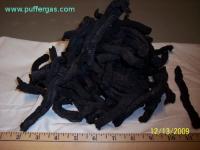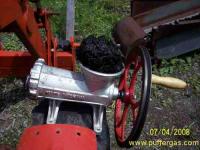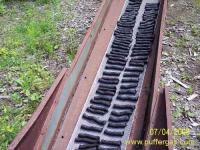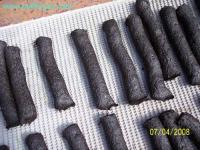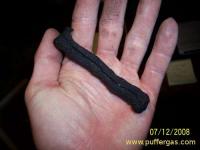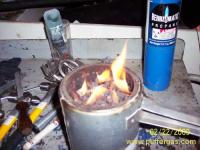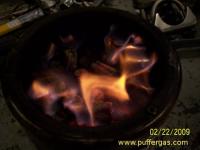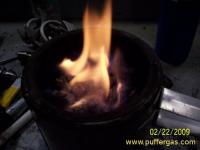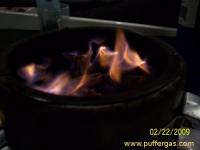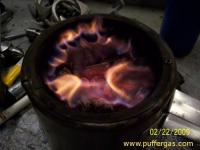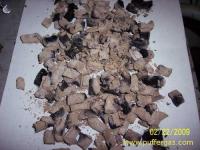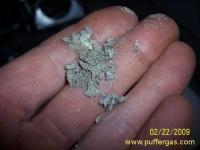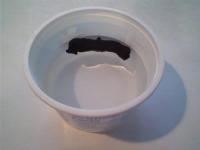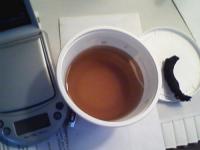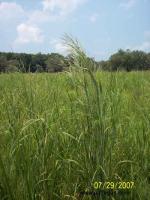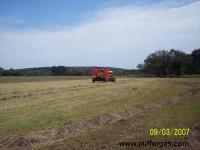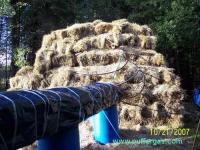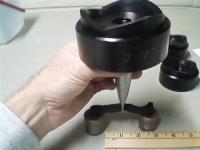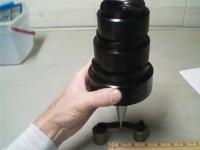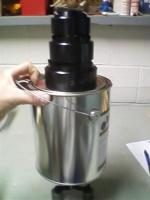Fuelage
by
Jeffrey R. Davis
www.puffergas.com
Abstract
Fuelage is a fuel and construction material made from grass or possibly other plant material. After the grass or other plant material has properly retted it is wet extruded in the form of a pellet and allowed to dry.
BACKGROUND:
In the fall of 2007 I was experimenting with composting as a source of space heating. This is called the Thermo-Biopile [2] and can be seen in photo 17. The plant material used was switch grass and wood chips. Photo 15 is the grass field before harvesting and photo 16 is the harvest photo. During the summer of 2008 I noticed a black material when the Thermo-Biopile was disassembled. I saved some of this material to test as a feed stock for Fireballs.
You can refer to my other article in order to understand the Fireballing process [5]. The first step was to place this material in a rotating drum with rocks and then after a period of ball milling the rocks were removed and the feedstock was left in the drum to see if it would agglomerate into balls. The consistency of the material would not allow this but it might be possible if another material was added.
It became obvious that this feedstock would be best used in an extruder so I modified a meat grinder that can be viewed in photo 1. The Fuelage is drying in photo 2 and 3. I'm not sure if this material needs to be milled (in this case ball milled) some before before extruding. An extruder could be designed to dewater and maybe mill this material, thus possibly a higher density particle and shorter drying period. Photo 4 is a picture of a dried particle.
ANALYSIS:
|
|
|
|
|
HHV |
12 MJ/kg |
|
|
LHV |
10 MJ/kg |
|
|
Water |
8.0% |
|
|
Total Carbon |
30.1% |
|
|
Total Hydrogen |
5.2% |
|
|
Total Oxygen |
41.0% |
|
|
Total Ash |
13.9% |
|
|
Total Sulfur |
<1 |
|
|
Total Nitrogen |
1.8% |
|
|
Particle Density |
0.760 |
|
|
Bulk Density |
0.471 |
|
|
|
|
|
|
|
as-Received |
Dry Weight |
|
Water |
8.0% |
0.0% |
|
Volatile Matter (HOS) |
34.4% |
37.5% |
|
Volatile Nitrogen (N) |
1.0% |
1.1% |
|
Volatile Org. Carbon (C) |
13.9% |
15.1% |
|
Fixed Matter (HOS) |
11.7% |
12.7% |
|
Fixed Nitrogen (N) |
0.8% |
0.9% |
|
Fixed Org. Carbon (C) |
16.2% |
17.6% |
|
Acid Soluble Ash |
9.0% |
9.8% |
|
Non-Acid Soluble Ash |
4.9% |
5.4% |
|
|
|
|
|
|
|
|
Chart 1
A sample was sent to a lab [1] for analysis and an abridged report is shown above in Chart 1. The full report can be down loaded [4]. My concerns with the result are the ash content, LHV and total oxygen. Switch grass ash content is less than 5% and Fuelage is about 14% so that would hint to a three fold loss in material. Switch grass LHV is about 18 Mj/kg where Fuelage is 10 Mj/kg thus hinting to even more loss. Furthermore oxygen percent is still present and high.
COMBUSTION:
Fuelage is surprisingly strong and can be in the form of a stick or a short particle. Short particles were prepared for testing in the Wood Gas Camp Stove , TLUD by Tom Reed [3], and the flames can be seen in Photos 5 through 10 along with the ash is in Photos 11 and 12. Below are the observations from the one test run.
Observations:
* Difficult to start.
* Fragile flame.
* Hot for such a fragile flame.
* Smokey
* Tested on low fan speed. Seemed to burn better when the fan was turned off and the fan was slowing down. But would not burn when fan was stopped.
* Had to be restarted a few time.
Apparently the combustion device will have to be tuned to this fuel.
It might be possible to use Fuelage in a rocket stove if it is made to stick length particles.
HYPOTHESIS:
The name Fuelage was chosen because it reminded me of silage which is a fermentation and preservation process. Also when sawdust is used to make alcohol acid is used and a black product is left. Silage bacteria end up making acid but I doubt that silage ends up being black. I do not know if the black color of Fuelage is because of acid or not, this is just my hypothesis and it is just a hypothesis that Fuelage is related to the ensilaging process. It could be related to the methane digester process or somewhere between the two.
First the aerobic organisms start breaking down the material because not all of the air has been removed even though the material is tightly packed. This is in regards to the ensilaging process. Unfortunately this consumes or wastes material but does warm the feedstock material so that the acidic anaerobic bacteria can take over. As time goes by, and other acidic anaerobic bacteria take over, too much acid is produced and the bacterial process stops. At this stage, as long as air is kept out, the material is preserved.
Unfortunately I never had the time to test this material with litmus paper to measure it's acidic level.
REWETTING:
A Fuelage particle was re-wetted to determine what the effects that water would have on this dried material. The particle stayed intact but lost strength and the surface felt slimy. Chart 2 shows the weight gain over a 24 hour period.
|
4g |
Dry |
|
5.5g |
2.5 hrs |
|
5.8g |
3.5 hrs |
|
7.7g |
24 hrs |
|
4g |
Re-Dried |
Chart 2
The soaking particle is in Photo 13. The soaking water turned a light brown color much like tea and that can be seen in Photo 14.
BREAK TEST:
To demonstrate the strength of this material I set two sockets 2 inches apart and placed a Fuelage particle across them as can be seen in Photo 18, 19 and 20. An anvil with about a 1/6 inch point was constructed and on top of this the weights were balanced. I incrementally added the below weights:
2 lbs
3 /12 lbs
5 1/2 lbs
7 1/2 lbs
9 lbs
11 lbs
19 lbs
At 19 lbs I stopped because I felt that it was unsafe to balance more than this with my setup. So it might be possible to use this as a construction material to produce something like ink pens, decorations etc.
CONCLUSION:
The negative aspects of Fuelage is the material and LHV loss also the ash and oxygen contents are high. On the positive side; it is a durable material and makes use of grass that would normally go to waste. Furthermore it stores wet, before extruding, for an extended amount of time. It becomes difficult to keep grass dry in some climates so this wet storage might be of interest.
---------
[1] Soil Control Lab, 42 Hanger Way, Watsonville CA 95076
[2] www.puffergas.com/pile/pile.html
[3] www.woodgas.com
[4] See file attachment.
[5] www.puffergas.comNike Air Jordan Retro 1 Red Black White - Buy Air Jordan 1 Retro (white / black / varsity red), Price: $60.85 - Air Jordan Shoes

